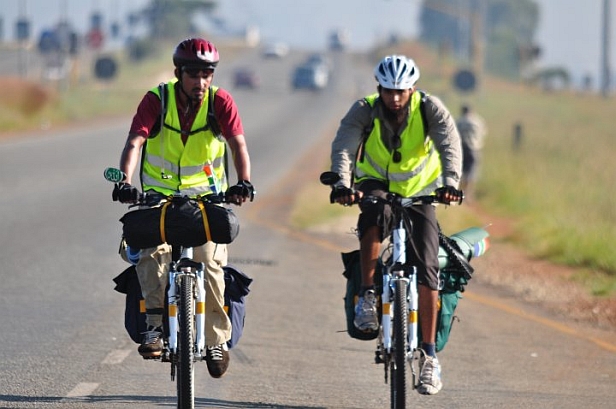 Getting people to do things differently is a big challenge.I wrote yesterday about the role of habit in human institutions and culture and the futility of trying to change habits through appeals to the rational mind. A few people asked, “Well then, smartypants, how do we change habits? What works?” I got a glimpse of an answer a few days ago.
Getting people to do things differently is a big challenge.I wrote yesterday about the role of habit in human institutions and culture and the futility of trying to change habits through appeals to the rational mind. A few people asked, “Well then, smartypants, how do we change habits? What works?” I got a glimpse of an answer a few days ago.
I spent most of the day Sunday in an intensive workshop run by Dr. Doug McKenzie-Mohr, a professor, consultant, and author of the book Fostering Sustainable Behavior: An Introduction to Community-Based Social Marketing. At a broad level, the workshop was focused on how to encourage sustainable behaviors, but more specifically, it was on the nuts-and-bolts details of how to construct an effective behavior-change program.
I’ll spare you most of the gory details (though they were oddly fascinating) and just share the main insight I took away from it.
Many folks, including me, are bullish on the role that behavior change can play in the climate effort. You may have heard about the “behavioral wedge,” the idea that changing consumer behaviors can be one of the famous wedges of the climate solution pie. Certainly the rest of the Behavior, Energy, and Climate Change Conference has been filled with some fairly grand pronouncements.
On that score, McKenzie-Mohr’s workshop was somewhat sobering. While the overall potential for behavior change may be high, changing people’s habits in a systematic way turns out to be a painstaking, labor-intensive undertaking.
Lots of people seem to hope/wish that it were simple. Many, many (many!) people cling to the notion that the way to motivate behavior change is simply to give people more information. Untold sums of money have been spent sending people brochures or sending them to websites where they can learn more; the results of those programs are almost uniformly dismal. Information is not motivation.
Others cling to a different illusion: that price alone can shift behavior, that financial self-interest is a kind of ur-motivation, trumping all others. Carbon pricing, according to the economist’s dream, will drive cascading behavior change across the entire economy. In fact, as McKenzie-Mohr illustrated at length, programs driven by economic incentives (rebates, etc.) have underperformed again and again. As he told me later, he’s a supporter of ecological tax reform, but we should be realistic:
The most that price can really do is enhance motivation to act. If we get the prices right, it does not make it any easier for the person who does not have a vehicle, or is physically disabled, to get down to the hardware to pick up a programmable thermostat. It just makes them feel more anxious about the fact that they ought to be doing it. How do we make it easier for people to make the transitions over to these other behavioral choices?
There is, it seems, no one-size-fits-all solution. In fact, McKenzie-Mohr stressed over and over that the first step in changing a behavior is to isolate it into a kind of indivisible unit. For each desired behavior change, there will be a unique set of barriers and benefits; successful programs will reduce the barriers and increase the benefits (or, he noted, raise barriers and reduce benefits of competing behaviors).
Here’s an example: Imagine you want to induce people to wrap their hot water heaters in an insulating blanket, reducing heat loss. Hard to think of a more specific behavior than that, right? Not so fast. There are two common types of hot water heaters, electric and natural gas. The panel that allows control access to electric waters heaters is on the side; on natural gas heaters, the controls are on top. There are different barriers to wrapping the different kinds of heaters. You have to tackle each individually.
So here’s how it works. You pick a set of behaviors you want to influence — say, things that can improve home energy efficiency. Then you pick apart the individual behaviors into indivisible units. Then you plot those units on a chart, where the Y axis is the amount of difference it can make (energy reduced, emissions avoided) and the X axis is how much effort it takes, i.e., how likely people are to do it. You pick the ones with the best combination of those two characteristics.
Once you’ve chosen the specific behaviors you want to target, you research the barriers and benefits that are most salient or motivating. You don’t guess at them — as people all too frequently do — because they’re often surprising or counterintuitive. You do the research. Then you select promising methods to reduce barriers and increase benefits and run a small pilot program; you keep at that until you find what works. Then, and only then, you scale up.
Now, replicate this over and over again for a whole broad array of behaviors, and you start to see the challenge of scaling this stuff up. I told him later how daunting and labor-intensive it seemed. He said:
If we skip [the work], we fail. If we want to get people to bike to work on a massive scale, we have to understand intimately what the barriers are to that behavioral choice — and they will differ for people in different locations — and put programs in place that make that behavior much more convenient than it is now, and at the same time make the competing behavior, single-occupant driving, less convenient. I wish there were easy solutions. But each of the behavioral changes we’d like to encourage have their own set of barriers. If we don’t understand what they are, we’re not going to build effective programs.
Can such a painstaking, behavior-by-behavior process ever scale up to what’s needed? McKenzie-Mohr is hopeful:
We’re seeing programs being delivered in Australia now at the level of hundreds of thousands of households — TravelSmart has been delivered to over a million households. It’s still not a societal-wide scale, but they’re scaling at a much larger level than what we see in North America.
Suffice to say, we’re a long way from that in the U.S. But there are no shortcuts, no way to get there except training people, sending them out to craft programs, creating toolkits so more communities can quickly adopt programs that work, and giving the work a serious place in our political discussion and funding.



